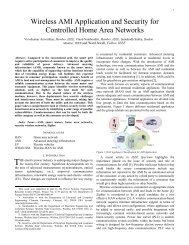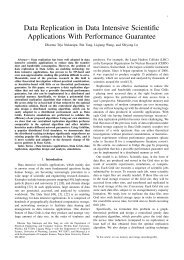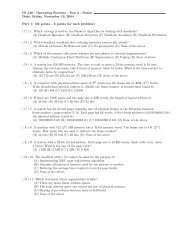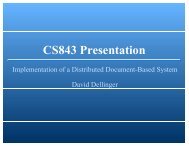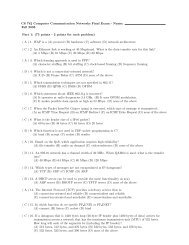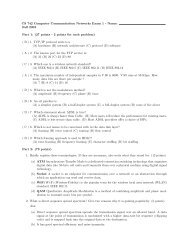Near-optimal Differentially Private Principal Components - NIPS
Near-optimal Differentially Private Principal Components - NIPS
Near-optimal Differentially Private Principal Components - NIPS
Create successful ePaper yourself
Turn your PDF publications into a flip-book with our unique Google optimized e-Paper software.
than SULQ method [2], which provides a general differentially-private input perturbation algorithm,this is the first work on differentially-private PCA. Independently, [14] consider the problemof differentially-private low-rank matrix reconstruction for applications to sparse matrices; providedcertain coherence conditions hold, they provide an algorithm for constructing a rank 2k approximationB to a matrix A such that kA Bk F is O(kA A k k) plus some additional terms whichdepend on d, k and n; here A k is the best rank k approximation to A. Because of their additionalassumptions, their bounds are generally incomparable to ours, and our bounds are superior for densematrices.The data-mining community has also considered many different models for privacy-preserving computation– see Fung et al. for a survey with more references [11]. Many of the models used havebeen shown to be susceptible to composition attacks, when the adversary has some amount of priorknowledge [12]. An alternative line of privacy-preserving data-mining work [28] is in the SecureMultiparty Computation setting; one work [13] studies privacy-preserving singular value decompositionin this model. Finally, dimension reduction through random projection has been consideredas a technique for sanitizing data prior to publication [18]; our work differs from this line of workin that we offer differential privacy guarantees, and we only release the PCA subspace, not actualdata. Independently, Kapralov and Talwar [16] have proposed a dynamic programming algorithmfor differentially private low rank matrix approximation which involves sampling from a distributioninduced by the exponential mechanism. The running time of their algorithm is O(d 6 ), where d isthe data dimension.3 Algorithms and resultsIn this section we describe differentially private techniques for approximating (2). The first is a modifiedversion of the SULQ method [2]. Our new algorithm for differentially-private PCA, PPCA,is an instantiation of the exponential mechanism due to McSherry and Talwar [22]. Both proceduresprovide differentially private approximations to the top-k subspace: SULQ provides (↵, )-differential privacy and PPCA provides ↵-differential privacy.Input perturbation. The only differentially-private approximation to PCA prior to this work isthe SULQ method [2]. The SULQ method perturbs each entry of the empirical second moment matrixA to ensure differential privacy and releases the top k eigenvectors of this perturbed matrix. Inparticular, SULQ recommends adding a matrix N of i.i.d. Gaussian noise of variance 8d2 log 2 (d/ )n 2 ↵and applies the PCA algorithm to A + N. This guarantees a weaker privacy definition known 2as(↵, )-differential privacy. One problem with this approach is that with probability 1 the matrixA + N is not symmetric, so the largest eigenvalue may not be real and the entries of the correspondingeigenvector may be complex. Thus the SULQ algorithm is not a good candidate for practicalprivacy-preserving dimensionality reduction.However, a simple modification to the basic SULQ approach does guarantee (↵, ) differentialprivacy. Instead of adding a asymmetric Gaussian matrix, the algorithm can add the a symmetricmatrix with i.i.d. Gaussian entries N. That is, for 1 apple i apple j apple d, the variable N ij is an independentGaussian random variable with variance2 . Note that this matrix is symmetric but not necessarilypositive semidefinite, so some eigenvalues may be negative but the eigenvectors are all real. Aderivation for the noise variance is given in Theorem 1.Algorithm 1: Algorithm MOD-SULQ (input pertubation)inputs: d ⇥ n data matrix X, privacy parameter ↵, parameteroutputs: d ⇥ k matrix ˆV k =[ˆv 1 ˆv 2 ··· ˆv k ] with orthonormal columns1 Set A = 1 n XXT .;2 Set = d+1n↵r ⇣2 logentries are i.i.d. drawn from N 0, 2 .;3 Compute ˆV k = V k (A + N) according to (2). ;⌘d 2 +d2 p + p 12⇡ ↵n. Generate a d ⇥ d symmetric random matrix N whose4






